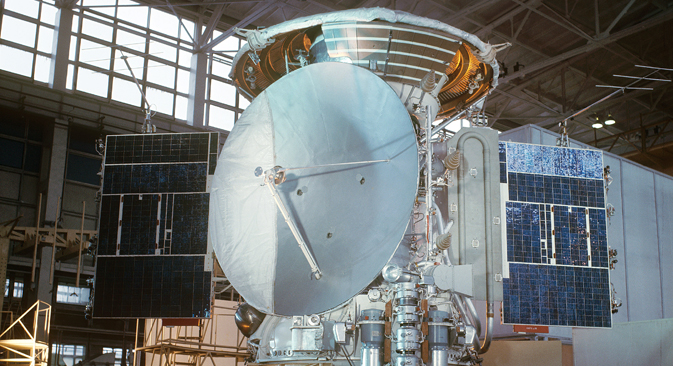
"Mars-3" inter-planetary station in the assembly shop, Moscow, 1971. Source: B. Borisov / TASS
A group of scientists and space enthusiasts from Russia is trying to figure out where the remnants of Soviet spacecraft Mars-6 are. They’ve already managed, thanks to the help of NASA satellites, to unearth where Mars-3 is.
This probe was the first spacecraft to successfully accomplish a landing on the Red Planet. The group is also going to search for the first Soviet mission on Mars, the Mars-2 probe, which was launched in May 1971. The spacecraft crashed during landing, but it became the first artificial object to land on Mars. According to scientists, studying these spacecrafts will help humankind in its conquest of the planet.
A few years ago space enthusiast Vitaly Egorov was surprised to learn that the location of the Soviet probes Mars-6 and Mars-2 still remains a mystery. Nobody had ever seen the Mars-3 spacecraft either. The latter had been the protagonist of a phenomenal achievement, the first successful landing of a spacecraft on Mars in December 1971.
The spacecraft ceased to transmit data just 14.5 seconds after landing. Although it only managed to transmit a panorama of the surrounding surface, it demonstrated that a successful landing on Mars was possible. “Over 40 years ago Mars-3 accomplished a landing almost in the same sequence as the American spacecraft Curiosity in 2012,” says Egorov.
Egorov began his search for the lost Soviet spacecrafts with the aid of pictures taken by the NASA Mars Reconnaissance Orbiter (MRO) scientific satellite. The latter is equipped with a high resolution HiRise camera.
“We accept image suggestions from anyone in the world at our website,” Alfred S. McEwen, director of the Planetary Image Research Laboratory of the University of Arizona and manager of the MRO HiRise scientific team, told RBTH.
Egorov assembled group of bloggers, space enthusiasts and scientists that discovered an object similar to a Soviet space probe in the shots taken by the MRO. He contacted Alexander Bazilevsky, a professor at the Vernadsky Institute of Geochemistry and Analytical Chemistry.
Thanks to his support, in March 2013 NASA organized another photo session with the MRO. In the pictures they could clearly identify an overturned axis with soft landing engines, the cone brake, the parachute and the landing module, which measured 1.5 meters. There were no doubts that it was the Mars-3 space probe.
Now the group set up by Egorov is trying to find out where Mars-6 is. The spacecraft entered the atmosphere of Mars in 1974. Immediately after landing it ceased all transmissions. According to one version, the breakdown was caused by a Martian storm that caught the probe while its soft landing engines were being started.
“According to the telemetry data, the spacecraft opened its parachute,” Egorov says. “We have been trying to find it, but so far to no avail. In the pictures that we have, we have noticed some dots that might have been produced by a descending module, but so far we have not gathered enough supporting evidence. We are waiting for new pictures of the area where the spacecraft presumably landed.”
According to McEwen, the study of the photographs taken by Mars-3 and Mars-6 helps scientists to understand the reasons for the troubles experienced by Soviet hardware.
“Any new high-resolution image may tell us something new and important about Mars,” says McEwen.
“An image of the old Soviet landing hardware can also provide information to the engineers about what did and did not work correctly.”
“From the pictures we can even determine the extent to which these Soviet spacecrafts have been covered by sand or dust,” Bazilevsky told RBTH. “This is one of the ways we have to study the atmosphere of the Red Planet, which is important for the construction of a future station on Mars. That planet’s atmosphere is so variable with periodic storms and strong winds, unlike the Moon where the traces of lunar spacecraft can remain intact for thousands of years.”
RBTH spoke to leading Russian scientists to find out what they have learned about the Chelyabinsk meteorite over the past two years.
GLONASS may become a key element in an international rescue network.
All rights reserved by Rossiyskaya Gazeta.
Subscribe
to our newsletter!
Get the week's best stories straight to your inbox